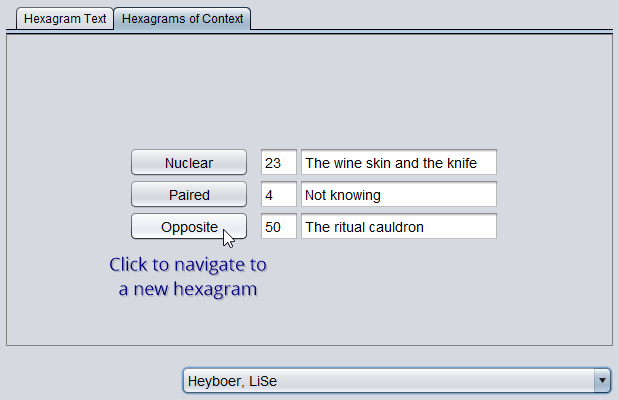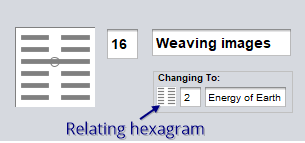You can browse ‘hexagrams of context’ in the dedicated tab in the hexagram browser window:

They’re also mentioned in the advanced search window, cast history search and Yijing reading cast tab (below the translation and commentary).
Primary hexagram
This is the original hexagram you cast. The answer to your question starts here.
Relating hexagram
The hexagram that appears when all moving lines have changed to their opposites:

The role of the relating hexagram varies, but expect it to tell you something about where you stand relative to the whole.
Nuclear hexagram
A hexagram created from the inner lines of an original hexagram. A hexagram’s lines are numbered 1 through 6 from bottom to top. To find its nuclear hexagram, you create a new hexagram from lines 2,3,4,3,4,5.
For instance, here’s Hexagram 50, the Vessel, and its nuclear hexagram 43, Deciding:

A nuclear hexagram describes a core reality that’s manifest in the original hexagram: the Vessel is one way that Deciding becomes manifest.
Paired hexagram
Each odd-numbered hexagram is paired with the even-numbered hexagram that follows: 1 with 2, 3 with 4 and so on.
Most hexagram pairs are created by inversion – Hexagram 4 is the same as Hexagram 3, just upside-down. Hexagrams that don’t change when inverted are paired with their opposites.
The paired hexagram shows you the ‘other side of the coin’.
Opposite hexagram
The hexagram created by changing all six lines; also known as the ‘complementary hexagram’. The opposite of Hexagram 50 is Hexagram 3, Sprouting:
| Hexagram 50,
the Vessel | Hexagram 3,
Sprouting |
Opposite hexagrams show you exactly what your answer isn’t – and can also show what’s needed for balance.
Patterns of change
The patterns of change are ‘map’ hexagrams showing only where a line is changing. In the yang pattern of change, each changing line is represented by a solid (yang) line and each unchanging line by a broken line. The yin pattern of change is the reverse: changing lines are represented by broken (yin) lines, unchanging lines by solid lines. Hence yin and yang change patterns are opposite hexagrams.
The patterns of change can describe a path through the reading. The yang pattern tends to describe how you encounter or enter the moment of the reading – it may be immediately recognisable as such. The yin pattern may show a way through. It can be helpful to reflect on how to attain an equilibrium between the two.
Steps of change
The step of change (or zhi gua) for each line is the hexagram created by changing that line alone – it will be the relating hexagram if only that line is changing.
In readings, they can be considered as a miniature relating hexagram for each changing line.
